Site pages
Current course
Participants
General
Topic 1
Topic 2
Topic 3
Topic 4
Topic 5
Topic 6
Topic 7
Topic 8
Topic 9
Lesson 4. SMITHY AND FORGING TOOLS AND EQUIPMENT
SMITHY AND FORGING TOOLS AND EQUIPMENT
4.1 Introduction
- A smithy’s work involves heating of a metal stock to a desired temperature, enable it to obtain sufficient plasticity, followed by the operations like hammering, bending, pressing etc., to give it the desired shape. This is known as forging.
- The above operations can either be carried out by hand hammering, by power hammers, or by forging machines.
- Hand forging is the term used for the process when it is done by hand tools. Similarly, forging done with the help of power hammers is known as power forging, when carried out by means of drop hammers as drop forging, and when by forging machines as machine forging.
- Applying pressure for shaping the metal, the primary requirement always is to heat the metal to a definite temperature to bring in into the plastic state.
- This may be done either in an open hearth, known as smith’s forge, or in closed furnace. Small jobs are normally heated in the Smith’s forge and larger jobs in closed furnaces.
- The Hand forging process is employed for relatively small components, machine forging for medium sized and large articles requiring very heavy blows and drop forging for mass production of identical parts.
4.2 Principal Tools and Other Equipments Used in Hand Forging
4.2.1 Smith’s forge or hearth
- It has a robust cast iron or steel structure consisting of 4 leg supports, an iron bottom known as hearth, a hood at the top and tuyere opening into the hearth either from the rear or from the bottom.
- The hearth carries the coal and provided with fire bricks lining to withstand the extensive heat produced due to the combustion of coal. In the absence of this lining the heat produced, as started above, will directly effect the metal structure of the hearth, so that the body, particularly the bottom and the surrounding walls, may even melt.
- With the result, the entire structure will collapse and the hearth will no more be useful.
- Air, under pressure is supplied by the blower, suitably placed somewhere near the forge, through the tuyere opening in the hearth.
- This blower can either be hand operated or power driven. The latter is preferable, but in the absence of availability of power supply choice of the former has no alternative.
- If hand blowers are to be used, they are usually mounted at the rear of the forge itself. In case the power driven units are to be employed the blower is suitably placed in one corner of the shop and all the forges are connected with it by means of a well-laid pipe running underground all around the hearths.
- At suitable points auxiliary pipes are used to connect the tuyere with the main pipe line.
- A valve is incorporated in the auxiliary pipe, just before the place where it is connected with the tuyere, to control the supply of air to the furnace.
- The chimney provided at the top enables as easy escape of smoke and gases produced due to the burning of coal.
- A water tank is provided, in front of the forge, which carries water for the purpose of quenching.
- These hearths can also be made to have masonry construction provided with all the attachments like chimney, tuyere, blower, water tank, etc.
4.2.2 Anvil
- To carry out the forging operations successfully, a proper supporting device is needed which should be capable of withstanding heavy blows rendered to the job.
- An anvil stands as the most appropriate choice for this purpose.
- Its body is generally made of cast steel, wrought iron or mild steel provided with a hardened top, about 20 to 25 mm thick.
- This hardened plate is welded to the body on the top.
- The horn or beak is used in bending the metal or forming curved shapes. The flat step provided, between the top and the horn, is used to support jobs during cutting and is known as chipping block.
- The flat projecting piece at the back of the anvil is known as tail.
- It carries a square hole to accommodate the square shank of the bottom part of various hand tools like swages, fuller. It is called a hardie hole.
- The circular hole provided near the hardie hole is known as pritchel hole.
- The commonly used size of an anvil weighs approximately 50-150 kg although it is manufactured in various sizes.
- The top face of the anvil should stand at about 0.75 m from the floor.

Fig. 4.1 Anvil
- The classification of hammers is largely according to the size and weight of the hammers used in forging.
- A smith’s hand hammer is a small sized hammer used by the smith himself and the sledge hammer is comparatively larger in size, heavier in weight and is used by the smith’s helper, known as hammer man.
- The smith’s hand hammer is normally a small sized ball peen hammer.

Fig. 4.2 Smithy hammers
All the hammers are mainly divided into 4 parts; namely peen, eye, cheeks and face. The peen is the top part made slightly tapered from the cheeks and rounded at the top. It gets a particular form known a ball peen hammer.
The face is hardened and polished well and is given slight rounding along the circular edges so that the metal surface is not spoiled by the sharp edges when the former is struck by the hammer.
The eye is normally made oval or elliptical in shape and accommodates the handle or shaft. For small sized hammers these handles are made of shisham wood or bamboo, but in case of sledge hammers the handles made of solid bamboos. A steel wedge is always forced into the handle after it is fitted into the hammer so as to prevent the slipping of the hammer off the handle during striking.
A smith’s hammer is usually a ball peen hammer or a straight peen sledge type hammer of relatively small size. Its weight normally varies between 1.0 kg and1.8 kg. A ball peen hammer is used for all general work and its peen is employed when light blows at a faster speed are needed, such as in fullering a rivet head in a countersunk hole.
Sledge hammers are comparatively 3to 4 times heavier than the hand hammers. They are available in varying sizes and weights from 3 kg to 8 kg. They are employed when heavy blows are needed in forging and other operations done on heavy jobs.
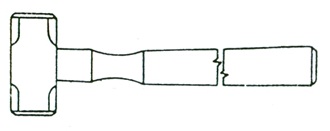
Fig. 4.3 Sledge hammer
4.2.4 Swage block
It is usually a block of cast steel or cast iron carrying a number of slots of different shapes and sizes along its four side faces and through holes from its top face to bottom face.
This is used as a support in punching holes and forming different shapes. The job to be given a desired shape is kept on a similar shaped slot, which acts as a bottom swage, and then the top swage is applied on the other side of the job.
The holes in the top and bottom face are used in punching. Their use prevents the punch from spoiling by striking against a hard surface after the hole has been punched.

Fig. 4.4 Swage block
4.2.5 Tongs
- They are used to hold the jobs in position and turning over during forging operation. They are made of mild steel.
- Tongs are usually made in two pieces, riveted together to form a hinge. Smaller length on one side of the hinge carries the holding jaws, which are made in different shapes and sizes to suit the corresponding shapes and sizes of the jobs, and the longer portions on the other side of the hinge form the arms which are held in hand by the smith.
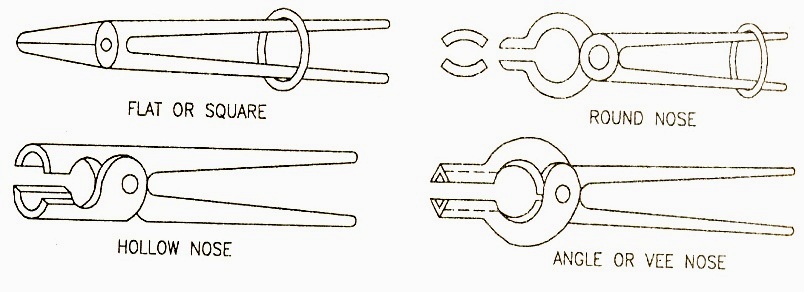
Fig. 4.5 Tongs
- Tongs are usually named after the inside shapes of the jaws.
- Flat tongs are used for gripping thin section and small flat pieces.
- Round hollow tongs, with curved surface inside, are used for holding round work.
- Hollow tongs with square jaws are used to hold square or hexagonal work. Pick up tongs have their jaws so shaped that even small sections can be easily picked up. They are not used for holding the work.
4.2.6 Chisels
- Chisels are used to cut metals in hot or cold state.
- Those which are used for cutting the metal in hot state are termed as hot chisels and the others used for cutting in cold state are known as cold chisels.
- The main difference between these chisels is in the included angle at the cutting edge.
- A cold chisel carries an included angle of 600 at the cutting edge and the latter is well hardened and tempered. It is made of high carbon steel.
- A hot chisel can be made of medium carbon steel as there is no need of hardening. It is used to cut the metal in plastic state. The included angle of its cutting edge is 300.
4.2.7 Punches
Punches are tapered tools made in various shapes and sizes. They are used for producing holes in red hot jobs. A larger tapered punch is called a drift.
The job is placed on the anvil and the punch is hammered through it up to about half its depth. In is then turned over and the punch made to pass through it.Completion of this operation in two stages prevents the job from splitting and full to bursting.
4.2.8 Flatters
These are also known as smoothers.They are made of high carbon steel and consist of a square body, fitted with a handle, and a flat square bottom. They are used for leveling and finishing a flat surface after drawing out or any other forging operation.
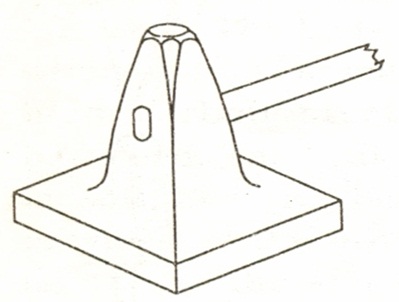
Fig. 4.6 Flatter
4.2.9 Set hammer
It is made of tool steel and hardened. It is not used for striking purpose. Its construction is also similar to that of a flatter but is smaller in size and it does not carry an enlarged bottom face. It is used for finishing corners, formed by two adjacent surfaces at right angles. The job is supported on the anvil and the tool is hammered from the top.
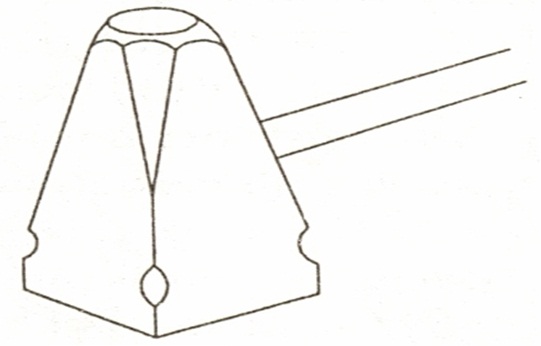
Fig. 4.7 Set hammer
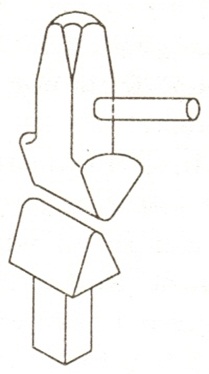
Fig. 4.8 Fullers
- Like fullers, they are also made of high carbon steel in two parts called the top and bottom swages.
- Their working faces carry circular grooves to suit the size of the work. They are available in various sizes.
- The top swage carries is a handle and the bottom swage a square shank to fit the hardie hole of the anvil during the operation.
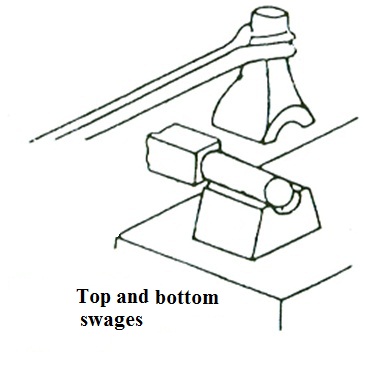
Fig. 4.9 Swages